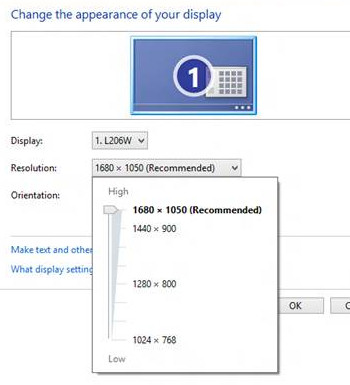Get the best display on your monitor
Windows chooses the best display settings for your PC based on your monitor. If you want to adjust your display settings, or if they were changed and you want to restore default settings, here are a few things you can try.
Show all
It's a good idea to set your monitor to the resolution it was designed to display (called the native resolution).
To see your monitor's native resolution, check the display settings in Control Panel.
-
 Tap or click to open Display.
Tap or click to open Display.
Tap or click Adjust resolution.
-
Tap or click the Resolution list and find the resolution marked (Recommended). This is your monitor's native resolution—usually the highest resolution your monitor can support.
 Screen Resolution in Control Panel shows the recommended resolution for your monitor.
Screen Resolution in Control Panel shows the recommended resolution for your monitor.
Monitors can support resolutions that are lower than their native resolutions, but text won't look as sharp and the display might be small, centered on the screen, edged with black, or stretched.
Recommended screen resolutions
|
Monitor size
|
Recommended resolution (in pixels)
|
|
19-inch standard ratio monitor
|
1280 × 1024
|
|
20-inch standard ratio monitor
|
1600 × 1200
|
|
20- and 22-inch widescreen monitors
|
1680 × 1050
|
|
24-inch widescreen monitor
|
1920 × 1200
|
|
Laptop screen size
|
Recommended resolution (in pixels)
|
|
13- to 15-inch standard ratio laptop screen
|
1400 × 1050
|
|
13- to 15-inch widescreen laptop screen
|
1280 × 800
|
|
17-inch widescreen laptop screen
|
1680 × 1050
|
|
Tablet screen
|
1360 × 768
|
You can set the brightness and contrast for most monitors using buttons or other controls on the monitor, not in Windows. If you aren't sure how to adjust the brightness and contrast on your monitor, check the manual or the manufacturer's website.
For most laptop screens, you can adjust brightness in Power Options in Windows.
-
 Tap or click to open Power Options.
Tap or click to open Power Options.
-
Under the plan that you want to change, tap or click Change plan settings.
-
On the Change settings for the plan page, choose the brightness settings that you want to use when your PC is running on battery (if applicable) and when it's plugged in.
If text and other items (like icons) on your screen are too small, you can make them larger without changing the screen resolution.
-
 Tap or click to open Display.
Tap or click to open Display.
-
Choose one of the following:
-
Smaller - 100% (default). This keeps text and other items at normal size.
-
Medium - 125%. This sets text and other items to 125% of normal size.
-
Larger - 150%. This sets text and other items to 150% of normal size. This option appears only if your monitor supports a resolution of at least 1200 x 900 pixels.
-
Tap or click Apply.
You'll see the change the next time you sign in to Windows.
You can also change the text size for specific items in Windows, like window title bars or tooltips, without changing the size of anything else on the screen.
-
 Tap or click to open Display.
Tap or click to open Display.
-
Under Change only the text size, choose the item you'd like to change and pick a text size. If you want the text to be bold, select the Bold check box.
-
Tap or click Apply.
You'll see the change the next time you sign in to Windows.
The ClearType technology in Windows helps make the text on your screen as clear and smooth as possible and can help make text easier to read over long periods of time. ClearType is turned on by default, but it's a good idea to make sure it wasn't turned off for some reason, especially if the text on your screen looks fuzzy.
-
 Tap or click to open the ClearType Text Tuner.
Tap or click to open the ClearType Text Tuner.
-
Make sure the
Turn on ClearType
check box is selected, and then tap or click Next. On each page, tap or click the text sample that looks best to you.
-
On the last page of the tuner, tap or click Finish to save your settings.
 You might be asked for an admin password or to confirm your choice.
You might be asked for an admin password or to confirm your choice.
If you have an older cathode ray tube (CRT) monitor, it's important to change the screen resolution to the highest resolution available that provides 32-bit color and at least a 72-Hertz refresh rate to prevent the screen from flickering.
Recommended resolutions for CRT monitors
|
Monitor size
|
Recommended resolution (in pixels)
|
|
15-inch CRT monitor
|
1024 × 768
|
|
17- to 19-inch CRT monitor
|
1280 × 1024
|
|
20-inch and larger CRT monitor
|
1600 × 1200
|
Note
CRT monitors generally don't come in widescreen sizes. Almost all have standard 4:3 screen and resolution ratios.